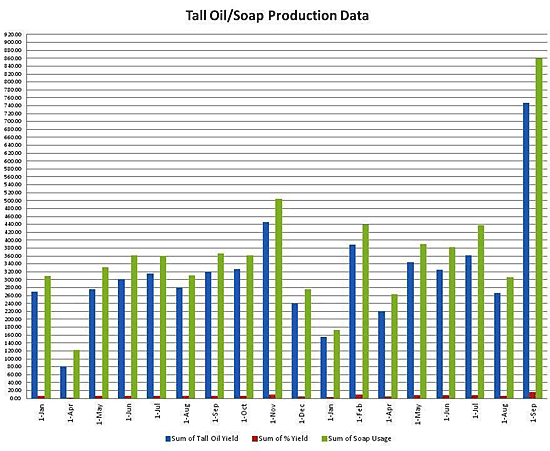Don't Forget the Organics!
 Print this article | Send to Colleague Print this article | Send to Colleague
During the past several years, the push for additional pulp production at maximum operating efficiency has led many mills to treat inorganic deposition in the evaporators to prevent fouling of heat transfer surfaces with various types of scale. However, the successful treatment of these inorganic scales has exposed the fact that many evaporator sets also suffer from organic fouling caused by common components from the liquor cycle, such as black liquor soaps, lignin, pitch, etc. It is crucial that mills evaluate both the organic and inorganic components that lead to fouling when working to optimize the operation of the evaporators.
Black Liquor Soap
When softwoods are pulped using the basic kraft process, wood acids (both resin and fatty) are converted into salts. These salts, as well as the resin and fatty esters that are also produced, separate from the black liquor as black liquor soap. Mills have a wide variety of separation equipment to try to remove the soap from the system and collect it for direct combustion or for the production of crude tall oil (CTO), which can be sold as a byproduct.
This soap, however, if not properly removed, can be directed to the evaporator sets and can quickly foul the heat transfer surfaces, reducing the ability to evaporate water and drastically reducing the operating efficiency of the set. Although some of the soap will pass through the entire evaporative process and provide an elevated heating value, and thus increased steam production at the recovery boiler, this benefit is negated by the loss of production to remove the organic material by boiling the set and the lost efficiency.
Improving Soap Removal Efficiency
There are two critical operating parameters that must be monitored to maximize the removal of soap. These parameters include:
- Residual Effective (or Active) Alkali of the spent cooking liquor: The minimum solubility for soap occurs when the Residual Effective Alkali (REA) of the weak black liquor is in the range of 6 to 8 grams per liter. Maintaining alkali content in this range by correct application of white liquor to the digester in the cooking process helps to keep this solubility in the correct range.
- Black Liquor Solids: Soap will begin to come out of solution at around 8% to 9% solids and reaches its maximum at 25 to 30% solids. Maintaining a fairly constant solids level leaving the digester (for continuous digesters) and from the brownstock washing area allows the soap recovery to be maximized.
Although other parameters, such as temperature, can impact how well soap separates from the black liquor, these can be much more difficult to control and are determined by production rates of the mill.
Specialty Chemical Solutions
In addition to controlling the process parameters listed above, the proper application of surfactant-based chemistries can also assist in flocculating the small soap particles to help them separate from the liquor quicker and easier. These products can have a significant impact on improving the yield of black liquor soap, which allows not only increased CTO production, but also can reduce the fouling of evaporator heat transfer surfaces.
An integrated pulp and paper mill in New Zealand was struggling with maximizing their soap removal due to frequently changing grades of pulp being produced in their Kamyr digester. These frequent grade changes caused dramatic swings in REA of the black liquor and the mill's evaporators were fouling frequently with the soap that was not being recovered. The evaporators were being boiled using condensate to remove this material every three to four days, which was hindering the production rate of pulp and thus limiting the output of the paper machines as well.
To correct the situation, a small feed of a surfactant-based soap separation aid (Infinity™ PS4068 pulp processing aid) was added to the black liquor being fed to the soap skimmers. In the first month, both soap and CTO production nearly doubled, and the fouling of the evaporators was reduced to the point where they were only boiled when the inventory of black liquor was low. Production rates for the mill were maximized as well.
Summary
The proper monitoring and control of organic material is just as important as controlling the inorganic non-process elements that foul a mill's evaporator set. These organics can quickly foul heat transfer surfaces of evaporator bodies, reducing both efficiency and throughput, which can prevent the mill from maximizing total production rate. Controlling key process parameters and potentially adding a small amount of chemistry to maximize removal of the organic materials can maintain the production capability of the evaporators and maximize profitability of the entire mill.

About the Author
Kraig Kent is global pulp and recovery applications team manager, Ashland Inc. He can be contacted by email.
|

